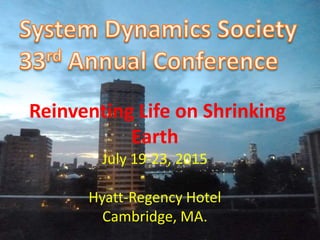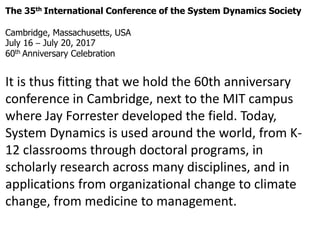Compexity and Climate: Crash in the World's Food Supply
- 1. MIT Prof. Jay Forrester’s System Dynamics PAUL H. CARR, MIT ’57 IEEE Life Fellow www.MirrorOfNature.org Complexity and Climate: Crash in the World’s Food Supply
- 2. MIT Prof. Jay W. Forrester (1918 -2016) Computer Pioneer and Founder of Complex System Dynamics, author of Urban Dynamics & World Dynamics In my conversation with him during the coffee hour at the Episcopal Church, Concord, MA, he suggested this web page:
- 3. A TRIBUTE TO JAY FORRESTER (1918 TO 2016) by Ralph Brower. “It was for a revolution I came to Concord, not the American Revolution that started with the Battle of Concord Bridge in April 19, 1775, but one led by a tall, lanky, white-haired former Nebraska prairie dweller named Jay Forrester. This revolution bears the title of system dynamics, words that promise to be as world shaking as the other ones that rocked Concord. They herald a change of perspective as radical as Emerson’s transcendentalism. Tall and rangy and looking as though he could still pitch a few bales of Nebraska hay, the founder of the movement was someone whose mind worked on a different level.”
- 4. “For all his sheer intellectual power, Forrester had the approachable manner of someone who grew up on the margins of rural America. He was the only major thinker/founder of a discipline, who sat in on papers delivered by high school teachers and then had lunch with them afterwards.”
- 5. •Simplistic "solutions" to complex problems are wrong (apt to fall into one of several traps set by the character of complex systems.) • Conflicts arise between short-term and long-term goals. Prof Jay Forrester’s Principles of System Dynamics
- 7. My conversation with Dennis Meadows, Ph. D. MIT, Second Author, Limits to Growth(1972) 2012 Creative Learning Exchange Conference mainly for Jr. & High School teachers. Babson Executive Conference Center Wellesley, MA July 1, 2012
- 8. 1.“Limits …”published in 1972. *Has sold 10 million copies *Predictions based on five major nonlinear feedback loops *In 2012, predictions were shown to be accurate & updated: -Meadows now predicts food production will crash in 2030 -Randers crash after 2052 2. 2011 UN IPCC Report predicts droughts & weather extremes will increase: threatening our food supply. 3. My June 2017 conference The Wicked Problem of Climate Change: What Is it doing to us and for us?
- 9. http://www.smithsonianmag.com/science-nature/Looking-Back-on-the-Limits-of-Growth.html#ixzz1rG5D2BHa LOOKING BACK ON THE LIMITS TO GROWTH (1972) World’s food production predicted to crash in 2030. Egypt whose population has quadrupled since 1950 is the world’s largest grain importer.
- 10. “Social systems belong to the class called multi-loop nonlinear feedback systems.” MIT Prof. Jay Forrester, World Dynamics Population
- 11. • Geologist M. King Hubbert predicted the 1970 peak in US oil production during 1956. • A 2nd peak is forecast for 2020. OIL RESOURCE DEPLETION
- 12. • FOSSIL FUELS WILL NOT MEET THE ENEGY DEMAND • NEED NEW WIND, SOLAR, AND NUCLEAR ENERGY
- 13. • Phosphorus fertilizer production is declining. • Large scale agriculture will not support the increasing population. NO SUBSTITUE FOR PHOSPHORUS
- 14. Absorbed CO2 increases acidity, reduces the calcification rate and nature’s ability to sequester carbon. INCREASING ACIDIFICATION THREATENS THE BOTTOM OF THE FOOD CHAIN
- 15. THE “WICKED PROBLEM” OF CLIMATE CHANGE: WHAT IS IT DOING TO US AND FOR US? 63nd Conference of the Institute on Religion in an Age of Science, www.iras.org June 24—July 1, 2017. Star Island off Portsmouth, NH. • Climate change is complex with causes and consequences in economic, ecological, ethical, and technological realms. • How can global warming be a catalyst for spiritual and societal transformation?
- 16. Solomon H. Katz, Ph.D is a leading expert on the anthropology of food, U of Penn. He was editor-in-chief of the Encyclopedia of Food and Culture published by Scribner (2003). Prof Katz was Chair of the AAA Task Force on World Food Problems. Barry Costa-Pierce, Ph.D, Chair of the Department of Marine Sciences, University of New England. Biddeford, Maine. Pioneer of the field of “Ecological Aquaculture” and helped develop the UN Food and Agriculture Organization’s global protocols. Can World Food Production Keep up with Population Growth in the Face of Climate Change & Sea Acidification?
- 17. Science Is the art of the provable. (empirical verification, fact-check) Religion is the art of the poetic (belief). Politics is the art of the possible. (What will people believe?)
- 18. Solar PVs on historic Star Island form the largest off-grid array in New England
- 19. Matthew Fox’s student wrote at major portion of Pope Francis’ 200 Page Encyclical Laudato Si: On Care for our Common Home. Theologian Rev. Dr. Matthew Fox. Creation Spirituality: How the Crisis of Climate Change Challenges Our Species to a New Evolutionary Awakening
- 20. Prophetic Pope Francis: • MORAL IMPERATATIVE: Stop plundering our planet for profit, the poor suffering the most. 200 Page Encyclical Laudato Si: On Care for our Common Home. June 2015
- 21. Carol Wayne White, Professor of Philosophy of Religion at Bucknell U. Humans are interconnected, social, & value-laden with the capacity for transformation Scientists: Paul H. Carr, PhD; Robert S. Pikart,PhD; Emily Austin,PhD & Bill Shoemaker,PhD. Chaplain. Rev. Dr. Mary E. Westfall Senior Minister at Community Church, UCC, Durham, Univ of NH Maintaining Hope, Acting for Justice
- 22. S Sunrise on Star Island , www.iras.org
- 23. Star Island 200 year-old Chapel
- 24. View from Chapel
- 25. SUNSET OVER PORTSMOUTH, NH FROM STAR ISLAND Learn more at www.iras.org
- 26. Physics Today, March 2012, pg. 31 NUMBER OF EVENTS WITH DAMAGE OVER $ 1 BILLION (NOAA) 2008: 9 2011: 14 Average since 1980: 3 to 4 • Since 1996 over $1 billion damage doubled compared with the previous 15-year period. Hurricane Katrina 2005: $146 B Hurricane Irene 2011: $15B Hurricane Sandy 2012: $50B
- 27. Social unrest correlates with food price increases. http://necsi.edu/research/social/foodcrises.html Russia Banned Grain Exports, Aug -Dec 2010, as Drought Cut Yields
- 28. The deserts in the US Southwest will expand into the central farm belt. - Farmable land in under-populated Canada will increase. Net decrease in food predicted. Farmland in under-populated Siberia will increase. - Farmland in over-populated China will decrease.
- 29. A Global Forecast for the Next 40 Years by Jorgen Randers, Ph. D. MIT 1973, Norwegian Business School 3rd author of “Limits to Growth” Agrees with Meadows: We are on an OVERSHOOT & CRASH mode, but CRASH could come after 2052
- 30. It Is Too Late For Sustainable Development Dennis Meadows, Ph. D. MIT Second Author, Limits to Growth (1972) Talk at Smithsonian Institution Washington, DC; February 29, 2012 2012 Creative Learning Exchange Conference mainly for Jr. & High School teachers. Babson Executive Conference Center Wellesley, MA July 1, 2012
- 31. We are not in the blue of “stabilized world” or soft landing mode. We are one the green “standard run” or OVERSHOOT an COLLAPSE mode
- 32. 2052: A Global Forecast for the Next Forty Years, by Jorgen Randers Food production will continue to increase while unused bio-capacity will decrease.
- 33. 2052: A Global Forecast for the Next Forty Years, by Jorgen Randers (co-author of “Limits to Growth, 1972) The main cause of future problems is the excessively short-term predominant political and economic model. “We need a system of governance that takes a more long-term view. It is unlikely that governments will pass necessary regulation to force the markets to allocate more money into climate friendly solutions, and must not assume that markets will work for the benefit of humankind”.
- 34. RESOURCE DEMAND AND POPULATION GROWTH by Jorgen Randers (3rd author of “Limits to Growth, 1972) 1 B population in the developed world (US & Europe) and resource demand will not increase. Enough food for those who can pay. 3 B population of China & BRISE (Brazil, Russia, India, South Africa and ten leading emerging economies) will increase demand for resources to increase GDP. 3 B remaining population will remain poor and largely undeveloped. World population growth will peak in 2045. CLIMATE CHANGE CHALLENGES NEW TECHNOLOGY DEVEL0PMENTS
- 35. Reinventing Life on Shrinking Earth July 19-23, 2015 Hyatt-Regency Hotel Cambridge, MA.
- 36. The 34th International Conference of the System Dynamics Society, Delft, Netherlands July 17 – July 21, 2016 Black Swans and Black Lies: System Dynamics in the Context of Randomness and Political Power-play System Dynamics has proven useful to analyze dynamically complex economic, social, and environmental issues. It is an effective methodology for designing robust systems and policies. Dynamics modeling can be used to understand resilience against shocks and to support implementation of policies, we address major epistemological and teleological questions.
- 37. The 35th International Conference of the System Dynamics Society Cambridge, Massachusetts, USA July 16 – July 20, 2017 60th Anniversary Celebration It is thus fitting that we hold the 60th anniversary conference in Cambridge, next to the MIT campus where Jay Forrester developed the field. Today, System Dynamics is used around the world, from K- 12 classrooms through doctoral programs, in scholarly research across many disciplines, and in applications from organizational change to climate change, from medicine to management.
- 38. Counterintuitiveness of Complex Systems http://www.clexchange.org/curriculum/complexsystems/default.asp By MIT Prof. JAY W. FORRESTER (1971) Author of World Dynamics • The intuitively obvious "solutions" to social problems are apt to fall into one of several traps set by the character of complex systems. • Cause and effect are not closely related in time or space. • Action is often ineffective because symptoms are treated, not the problem. -The cause of the problem is within the system. • Conflicts arise between short-term and long-term goals.
- 39. COUNTERINTUITIVE BEHAVIOR OF SOCIAL SYSTEMS By MIT Prof. JAY W. FORRESTER (1971) The human mind is not adapted to interpreting how social systems behave. Social systems belong to the class called multi-loop nonlinear feedback systems. In the long history of evolution it has not been necessary until very recent historical times for people to understand complex feedback systems. Evolutionary processes have not given us the mental ability to interpret properly the dynamic behavior of those complex systems in which we are now imbedded. Society becomes frustrated as repeated attacks on deficiencies in social systems lead only to worse symptoms. Because dynamic behavior of social systems is not understood, government programs often cause exactly the reverse of desired results. As another example, symptoms of excess population are beginning to overshadow all countries. Symptoms appear as urban crowding and social pressure. Rather than face the rising population problem squarely, governments try to relieve the immediate pressures by more policemen, financial aid, busing to suburban schools, and subsidized health facilities. As a consequence, increasing population reduces the quality of life for everyone.
- 40. STRATEGIC DECISION MAKING Richard Knowles’ Complexity Principle The degree of disagreement among social system members is proportional to its complexity.
- 41. 1.“Limits …”published in 1972. *Has sold 10 million copies *Predictions based on five major nonlinear feedback loops *In 2012, predictions were shown to be accurate & updated: -Meadows now predicts food production will crash in 2030 -Randers crash after 2052 2. 2011 UN IPCC Report predicts droughts & weather extremes will increase: threatening our food supply. 3. My June 2017 conference The Wicked Problem of Climate Change: What Is it doing to us and for us?









































